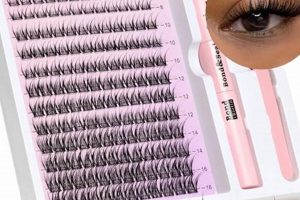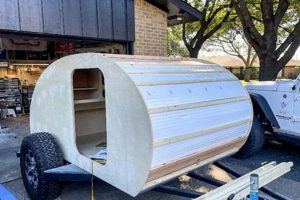The assembly of materials marketed for unsupervised teeth straightening constitutes a do-it-yourself orthodontic system. These products often consist of aligners, impression materials, and instructions intended to allow individuals to address perceived dental misalignments without direct professional supervision. An example involves purchasing aligners online after taking dental impressions at home, foregoing in-person consultations with an orthodontist.
The accessibility and affordability offered by these systems appeal to some consumers. Historically, orthodontic treatment has been a significant financial investment, potentially creating a barrier to access for certain segments of the population. This pursuit of a cost-effective alternative, however, raises concerns regarding potential risks associated with undertaking orthodontic movement without expert guidance.
The following sections will delve into the potential consequences, regulatory considerations, and professional perspectives surrounding unsupervised orthodontic approaches, examining the implications for dental health and overall well-being.
Considerations Before Pursuing Unsupervised Orthodontic Treatment
Engaging with self-directed dental alignment methodologies necessitates a thorough understanding of potential risks and limitations. The following guidelines offer critical points for consideration before initiating such a course of action.
Tip 1: Understand the Scope of Treatment: Recognize that unsupervised systems may be appropriate only for minor aesthetic adjustments. Complex malocclusions involving significant skeletal discrepancies require professional assessment and intervention.
Tip 2: Assess Oral Health Status: Ensure the absence of active periodontal disease or untreated caries. Orthodontic movement in the presence of such conditions can exacerbate existing problems and compromise dental health.
Tip 3: Scrutinize Material Safety and Quality: Verify that aligner materials are biocompatible and manufactured to acceptable standards. Substandard materials may release harmful substances or lack the necessary mechanical properties.
Tip 4: Appreciate the Importance of Professional Monitoring: Acknowledge that remote monitoring cannot fully replicate the benefits of in-person clinical examinations. Regular professional check-ups are essential for identifying and addressing unforeseen complications.
Tip 5: Recognize the Potential for Irreversible Damage: Appreciate that improperly executed tooth movement can lead to root resorption, bone loss, and temporomandibular joint disorders, potentially resulting in permanent dental damage.
Tip 6: Thoroughly Research the Provider: Investigate the credentials and reputation of the company offering the system. Look for transparent information regarding manufacturing processes, material composition, and customer support resources.
Tip 7: Document the Process: Take detailed photographs of dental alignment before, during, and after treatment. This documentation can be crucial in assessing progress and identifying any adverse effects.
Careful consideration of these points can aid in mitigating potential risks associated with direct-to-consumer dental alignment methods. However, a consultation with a qualified orthodontist remains the most prudent course of action for achieving optimal and predictable results.
The subsequent sections will explore the regulatory landscape and ethical implications of these emerging dental practices.
1. Misalignment Severity Assessment and DIY Braces Kits
The suitability of direct-to-consumer orthodontic aligners hinges significantly on an accurate evaluation of misalignment severity. Determining whether a malocclusion falls within the treatment capabilities of these systems is paramount to ensure efficacy and minimize potential harm.
- The Limits of Self-Diagnosis
Individuals considering these kits often lack the diagnostic expertise necessary to accurately assess their own malocclusion. While some companies provide remote consultations or questionnaires, these assessments typically cannot replicate the thoroughness of a clinical examination conducted by a qualified orthodontist. This limitation can result in individuals pursuing treatment for conditions that are beyond the scope of these aligners.
- Complexity Beyond Alignment
Misalignment severity involves more than just the visible crowding or spacing of teeth. Underlying skeletal discrepancies, impacted teeth, and temporomandibular joint disorders may contribute to the malocclusion. Such complexities require specialized diagnostic tools, such as cephalometric radiographs and cone-beam computed tomography, and treatment strategies that fall outside the purview of DIY systems.
- Risk of Inadequate Treatment
When individuals underestimate the severity of their misalignment, the aligners may fail to deliver adequate corrective forces. This can lead to incomplete treatment, relapse of the malocclusion, or even exacerbate existing dental problems. The pursuit of a perceived quick fix can result in a more complex and costly orthodontic problem in the long run.
- The Role of Professional Oversight
Orthodontic treatment is a dynamic process that requires ongoing monitoring and adjustments. A qualified orthodontist can track tooth movement, identify potential complications early, and modify the treatment plan as needed. The absence of such oversight in DIY systems significantly increases the risk of adverse outcomes, particularly in cases of moderate to severe misalignment.
The effectiveness and safety of unsupervised aligner systems depend critically on the proper assessment of misalignment severity. While these systems may be suitable for minor aesthetic adjustments, individuals with more complex malocclusions should seek comprehensive evaluation and treatment from a qualified orthodontic professional. Failure to do so can compromise dental health and lead to potentially irreversible damage.
2. Material biocompatibility verification
In the context of do-it-yourself orthodontic aligner systems, material biocompatibility verification is paramount to ensuring patient safety and minimizing adverse reactions. The materials used in these aligners come into direct and prolonged contact with oral tissues; therefore, a rigorous assessment of their potential to cause harm is critical.
- Regulation and Standards
Established regulatory bodies, such as the FDA in the United States and similar agencies worldwide, set standards for medical device materials. These standards mandate biocompatibility testing, which inc
ludes assessing cytotoxicity, sensitization, and irritation potential. Compliance ensures a minimum level of safety for end-users of these systems. - Potential Adverse Reactions
The oral cavity presents a complex environment, and materials used in aligners can trigger a range of adverse reactions. These may include allergic responses, mucosal irritation, gingival inflammation, and, in rare cases, systemic effects. Thorough biocompatibility testing aims to identify materials that are more likely to cause such reactions, allowing manufacturers to select safer alternatives.
- Material Degradation Products
Some materials may degrade over time in the oral environment, releasing byproducts that could be harmful. Biocompatibility verification includes assessing the stability of the material and identifying any potentially toxic degradation products. Understanding these factors is crucial for predicting long-term safety.
- Manufacturer Transparency and Certification
The onus is on manufacturers of self-directed orthodontic systems to provide clear documentation of biocompatibility testing. Consumers should seek assurance that materials have been independently tested and certified to meet recognized standards. Lack of transparency in this area raises concerns about the safety and quality of the product.
The integration of non-biocompatible materials in direct-to-consumer orthodontic aligners poses significant risks to oral and systemic health. While cost-effectiveness may be a driving factor in the adoption of these systems, consumers must prioritize products with verifiable evidence of material biocompatibility, ensuring a safer approach to self-administered orthodontic treatment.
3. Professional Oversight Absence and DIY Braces Kits
The defining characteristic of a do-it-yourself orthodontic system is the absence of direct, ongoing professional supervision by a qualified orthodontist. This lack of oversight introduces a range of potential complications and significantly alters the risk-benefit profile of orthodontic treatment. Traditional orthodontics involves a comprehensive examination, diagnosis, treatment planning, and continuous monitoring throughout the process. These steps are largely bypassed in unsupervised systems, placing the onus on the consumer to manage their own dental alignment.
The absence of professional scrutiny can lead to misdiagnosis of underlying dental or skeletal issues. For instance, undiagnosed periodontal disease may worsen with tooth movement, resulting in bone loss and potential tooth loss. In cases of significant skeletal discrepancies, unsupervised tooth alignment can camouflage the problem without addressing the root cause, potentially leading to temporomandibular joint dysfunction or other long-term complications. A further example is the failure to detect or address impacted teeth, which can complicate tooth movement and necessitate surgical intervention. Even in seemingly straightforward cases of minor crowding, unforeseen complications like root resorption can occur without early detection and intervention by a professional.
Therefore, while the affordability and convenience of unsupervised systems are attractive, the potential for irreversible damage due to the absence of professional oversight warrants careful consideration. Consumers must weigh the perceived benefits against the inherent risks of undertaking orthodontic treatment without expert guidance and monitoring, and ideally seek a professional opinion before commencing any such procedure.
4. Potential complications awareness
The utilization of direct-to-consumer orthodontic aligners, commonly marketed as components of “diy braces kit”, necessitates a comprehensive understanding of potential complications. Insufficient awareness precipitates adverse outcomes, transforming a pursuit of cosmetic improvement into a source of lasting dental and skeletal impairment. Examples of such outcomes include, but are not limited to, root resorption, where the tooth roots shorten, jeopardizing long-term stability; gingival recession, exposing root surfaces and increasing sensitivity; and temporomandibular joint disorders, resulting from improperly aligned occlusion and subsequent strain on the jaw joints. The absence of professional monitoring during this process removes a critical safeguard against these potential complications.
The significance of “Potential complications awareness” within the context of “diy braces kit” use extends beyond simply acknowledging the possibility of adverse effects. It demands a proactive approach, involving thorough research into potential risks, realistic expectation setting regarding treatment outcomes, and a commitment to vigilance in monitoring progress. It emphasizes the critical difference between supervised professional orthodontics, which inherently incorporates mechanisms for early detection and management of complications, and the unmonitored approach of using “diy braces kit”, which often lacks these vital protections. Furthermore, it mandates a clear understanding that the marketing materials of these kits often present an oversimplified picture of orthodontic treatment, potentially misleading individuals about the true complexities and associated risks.
In summary, “Potential complications awareness” constitutes an indispensable component of informed decision-making regarding “diy braces kit”. Failure to recognize and adequately address the risks inherent in unsupervised orthodontic treatment can lead to detrimental consequences for dental and overall health. The challenges in this area involve not only disseminating accurate and accessible information about potential complications but also fostering a culture of critical evaluation of the claims made by direct-to-consumer orthodontic companies. The broader theme underscores the importance of professional guidance in healthcare decisions, particularly when interventions, such as orthodontic treatment, involve irreversible alterations to the body.
5. Regulatory compliance uncertainty
The rise of direct-to-consumer orthodontics, exemplified by “diy braces kit,” introduces significant regulatory compliance uncertainty. This stems from the nebulous classification of these products and services under existing regulatory frameworks. The lack of clear guidelines creates ambiguity regarding manufacturing standards, material safety, and the scope of permissible claims. One immediate effect is that companies offering these kits may operate without the same level of scrutiny as traditional orthodontic practices. For example, aligner materials may not be subject to rigorous biocompatibility testing, potentially exposing users to adverse reactions. The absence of mandated professional oversight further complicates regulatory enforcement, as companies may disclaim responsibility for outcomes, leaving consumers vulnerable to substandard treatment.
The practical significance of “Regulatory compliance uncertainty” is manifested in the inconsistent quality and variable safety profiles of “diy braces k
it” offerings. While some companies may adhere to high standards voluntarily, others may prioritize cost-cutting measures that compromise product integrity. Consider instances where aligners are manufactured with inadequate precision, leading to ineffective tooth movement or even damage to dental structures. Furthermore, the absence of standardized protocols for remote monitoring and treatment adjustment raises concerns about the overall efficacy and safety of these systems. The “Regulatory compliance uncertainty” underscores the need for greater transparency and accountability within the direct-to-consumer orthodontic industry. Without clear legal and regulatory parameters, consumers are inherently at risk of receiving inadequate or even harmful dental treatment.
In conclusion, “Regulatory compliance uncertainty” presents a considerable challenge to ensuring the safety and effectiveness of “diy braces kit.” The absence of clear standards regarding manufacturing, materials, and professional oversight undermines consumer protection and creates potential for adverse dental outcomes. Addressing this regulatory gap requires a concerted effort from government agencies, dental professional organizations, and industry stakeholders to establish well-defined guidelines that balance innovation with patient safety. The complexities must be examined with an objective and evidence-based approach, fostering a level playing field where companies operate responsibly and consumers are equipped with the information needed to make informed decisions.
6. Long-term dental health risks
The utilization of self-administered orthodontic systems, commonly known as “diy braces kit,” introduces a spectrum of long-term dental health risks that warrant careful consideration. These risks stem primarily from the absence of professional evaluation, treatment planning, and ongoing monitoring, all of which are integral components of conventional orthodontic care.
- Root Resorption and DIY Braces Kits
Root resorption, the shortening of tooth roots, is a recognized risk associated with orthodontic treatment. Forces applied to teeth during movement can stimulate cells that break down root structure. In traditional orthodontics, professionals use X-rays to monitor root length and adjust treatment accordingly. “diy braces kit” often lacks such monitoring, potentially leading to severe and irreversible root shortening, compromising tooth stability and longevity. A case study might reveal significant root resorption in an individual using a “diy braces kit” for an extended period without professional oversight, ultimately requiring extraction of the affected teeth. Root resorption is more severe with the unsupervised approach.
- Gingival Recession and DIY Braces Kits
Improperly directed tooth movement can result in gingival recession, where the gum line recedes, exposing more of the tooth root. This exposure can lead to increased sensitivity, an elevated risk of root decay, and aesthetic concerns. Force vectors not properly calculated can lead to recession. In supervised orthodontic treatment, professionals meticulously control force application to minimize the risk of gingival recession. However, with “diy braces kit,” users may lack the necessary knowledge to apply forces correctly, increasing the likelihood of recession, which will have long-term ramifications.
- Temporomandibular Joint (TMJ) Disorders and DIY Braces Kits
Orthodontic treatment can impact the temporomandibular joint, the hinge connecting the jaw to the skull. Misalignment or alteration of the bite can place undue stress on the TMJ, potentially leading to pain, clicking, and limited jaw movement. A professional orthodontist carefully assesses the patient’s occlusion and TMJ function before and during treatment to mitigate these risks. “diy braces kit” lack the necessary diagnostic tools and expertise to identify and manage TMJ issues, increasing the potential for the development or exacerbation of TMJ disorders. Such issues may involve a lifetime of discomfort.
- Loss of Alveolar Bone Support and DIY Braces Kits
The alveolar bone supports teeth; its loss can lead to tooth loosening and eventual tooth loss. Incorrect force vectors and failure to consider the health of the periodontium can both result in alveolar bone loss. A professional orthodontist has tools and experience to mitigate risks. A DIY approach removes this. Alveolar bone loss can lead to more invasive and expensive dental care later.
The discussed long-term dental health risks are directly related to the unsupervised nature of “diy braces kit.” While affordability and convenience may be appealing, the potential for irreversible damage to teeth, gums, and jaw joints necessitates careful consideration. Consultation with a qualified orthodontist remains the most prudent approach to achieving safe and effective orthodontic treatment.
7. Efficacy predictability challenges
The relationship between “efficacy predictability challenges” and “diy braces kit” is characterized by a high degree of uncertainty and variability. Standard orthodontic treatment involves a thorough assessment of the patient’s dental structure, bite, and overall health. A customized treatment plan is then developed, and progress is carefully monitored and adjusted by an orthodontist. “Diy braces kit,” in contrast, often relies on self-assessment and a standardized approach, leading to unpredictable results. The absence of professional evaluation limits the ability to accurately foresee the outcome of treatment. A case in point involves individuals with underlying skeletal discrepancies that are not addressed by aligners, leading to ineffective tooth movement and potential exacerbation of the original problem.
The practical significance of understanding “efficacy predictability challenges” stems from the potential for wasted time and resources, as well as the risk of irreversible damage. For example, an individual using a “diy braces kit” may experience tooth movement that is cosmetically appealing but functionally unsound. This can create imbalances in the bite that lead to temporomandibular joint disorders or uneven wear of the teeth. Additionally, the lack of control over force application can result in root resorption or bone loss, compromising the long-term health of the teeth. Furthermore, the limited diagnostic tools available in a “diy braces kit” mean that underlying problems, such as impacted teeth or periodontal disease, may go undetected and untreated, further reducing the predictability of successful outcomes. If a company promises predictable results when this is not truly possible, this is unethical.
In summary, the “efficacy predictability challenges” associated with “diy braces kit” are substantial and should be a primary consideration for anyone contemplating this form of treatment. The absence of professional assessment, personalized treatment planning, and ongoing monitoring renders the outcomes highly uncertain, with the potential for both cosmetic and functional compromises. Individuals should carefully weigh the perceived benefits of convenience and affordability against the significant risks of unpredictable results and potential harm to their dental health. Consulting with a qualified orthodontist remains the most prudent approach to achieving predictable and safe orthodontic treatment.
Frequently Asked Questions Regarding DIY Braces Kits
The following addresses common inquiries concerning self-administered orthodontic alignment systems, providing concise, factual responses based on current understanding of dental health and regulatory considerations.
Question 1: Are DIY braces kits as effective as traditional orthodontic treatment?
The efficacy of DIY braces kits varies significantly and depends on the complexity of the individual’s malocclusion. These kits are generally suitable only for minor aesthetic corrections and may not be effective for more severe cases requiring professional intervention.
Question 2: What are the potential risks associated with using DIY braces kits?
Potential risks include, but are not limited to, root resorption, gingival recession, temporomandibular joint disorders, and tooth loss. Improper tooth movement without professional monitoring can lead to irreversible damage.
Question 3: Are DIY braces kits regulated by dental boards?
Regulatory oversight of DIY braces kits is currently limited and varies by jurisdiction. Consumers must exercise caution, as these products may not be subject to the same rigorous standards as those used in traditional orthodontic practices.
Question 4: Can a general dentist provide oversight for DIY braces kit treatment?
General dentists may not have the specialized training and experience required to effectively monitor and manage orthodontic treatment, even with DIY kits. Consultation with a qualified orthodontist is advisable.
Question 5: How do I determine if a DIY braces kit is appropriate for my specific dental condition?
A comprehensive evaluation by a qualified orthodontist is essential to determine the suitability of any orthodontic treatment, including DIY options. Self-assessment alone is insufficient.
Question 6: What should one do if complications arise during the use of a DIY braces kit?
If complications arise during the use of a DIY braces kit, discontinue use immediately and seek professional evaluation from an orthodontist.
In summary, DIY braces kits present both potential benefits and significant risks. Individuals should carefully consider these factors and consult with a qualified professional before embarking on self-directed orthodontic treatment.
The subsequent article section will delve deeper into the legal and ethical implications surrounding DIY orthodontic products.
Conclusion
The preceding analysis has explored various facets of “diy braces kit,” encompassing potential benefits, inherent risks, regulatory ambiguities, and professional perspectives. The absence of direct, consistent oversight from a qualified orthodontic professional emerged as a central concern, impacting treatment efficacy, safety, and the predictability of long-term dental health outcomes.
The availability of “diy braces kit” raises critical questions about the balance between consumer accessibility and patient safety within the orthodontic industry. Individuals considering these systems should carefully weigh the potential risks against perceived benefits, consulting with a qualified professional before undertaking unsupervised treatment. Further research and stricter regulatory oversight are needed to ensure that direct-to-consumer orthodontic products meet appropriate standards of safety and effectiveness.







